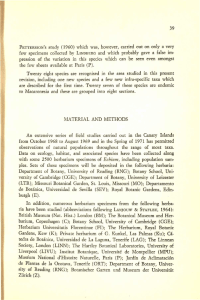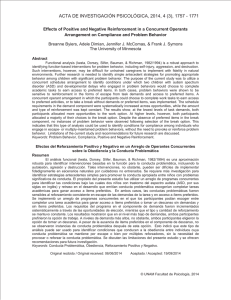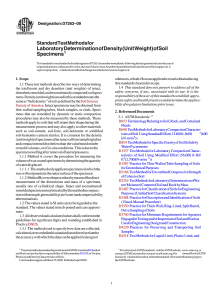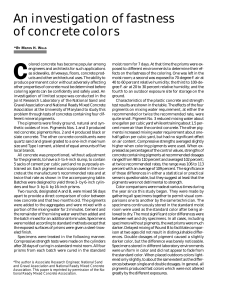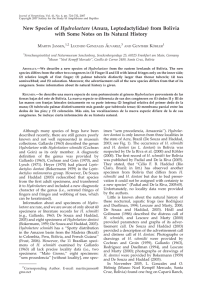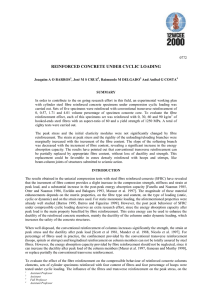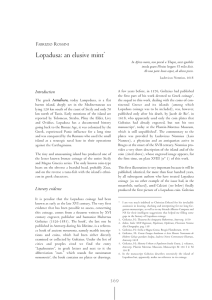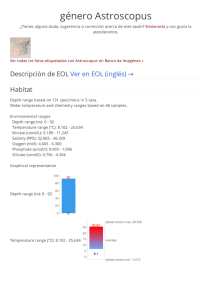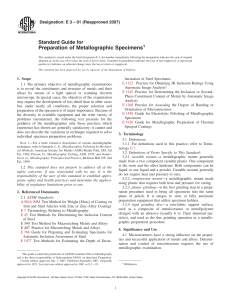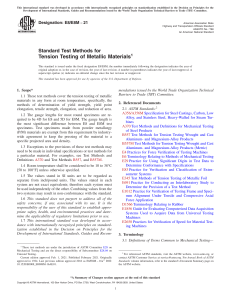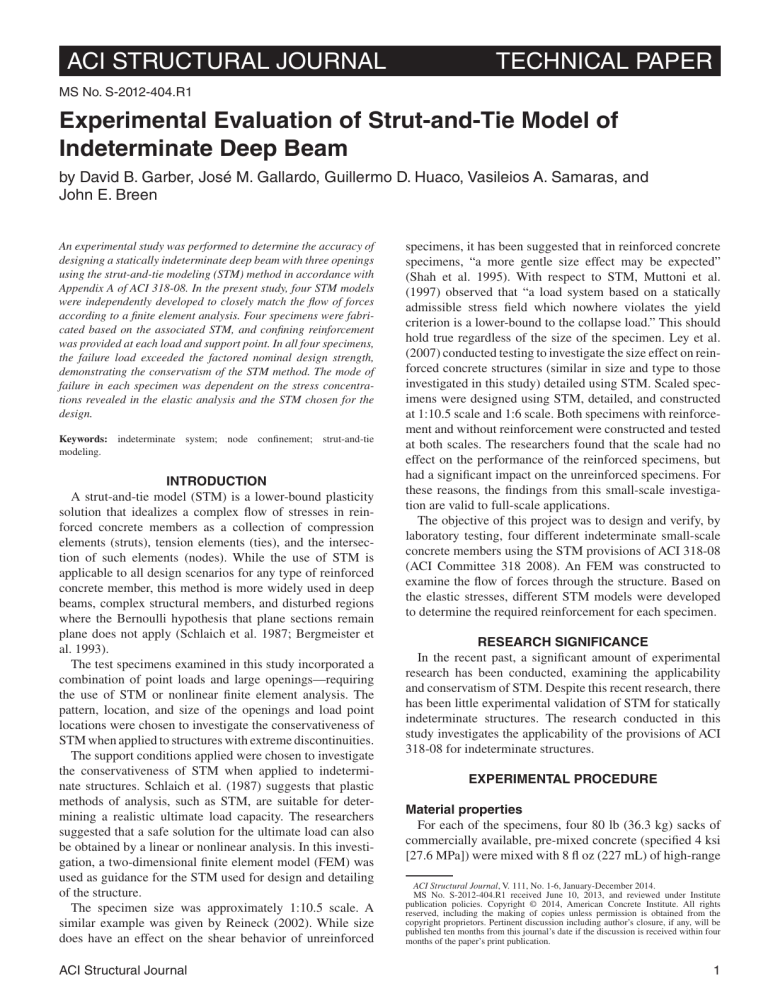
ACI STRUCTURAL JOURNAL TECHNICAL PAPER MS No. S-2012-404.R1 Experimental Evaluation of Strut-and-Tie Model of Indeterminate Deep Beam by David B. Garber, José M. Gallardo, Guillermo D. Huaco, Vasileios A. Samaras, and John E. Breen An experimental study was performed to determine the accuracy of designing a statically indeterminate deep beam with three openings using the strut-and-tie modeling (STM) method in accordance with Appendix A of ACI 318-08. In the present study, four STM models were independently developed to closely match the flow of forces according to a finite element analysis. Four specimens were fabricated based on the associated STM, and confining reinforcement was provided at each load and support point. In all four specimens, the failure load exceeded the factored nominal design strength, demonstrating the conservatism of the STM method. The mode of failure in each specimen was dependent on the stress concentrations revealed in the elastic analysis and the STM chosen for the design. Keywords: indeterminate system; node confinement; strut-and-tie modeling. INTRODUCTION A strut-and-tie model (STM) is a lower-bound plasticity solution that idealizes a complex flow of stresses in reinforced concrete members as a collection of compression elements (struts), tension elements (ties), and the intersection of such elements (nodes). While the use of STM is applicable to all design scenarios for any type of reinforced concrete member, this method is more widely used in deep beams, complex structural members, and disturbed regions where the Bernoulli hypothesis that plane sections remain plane does not apply (Schlaich et al. 1987; Bergmeister et al. 1993). The test specimens examined in this study incorporated a combination of point loads and large openings—requiring the use of STM or nonlinear finite element analysis. The pattern, location, and size of the openings and load point locations were chosen to investigate the conservativeness of STM when applied to structures with extreme discontinuities. The support conditions applied were chosen to investigate the conservativeness of STM when applied to indeterminate structures. Schlaich et al. (1987) suggests that plastic methods of analysis, such as STM, are suitable for determining a realistic ultimate load capacity. The researchers suggested that a safe solution for the ultimate load can also be obtained by a linear or nonlinear analysis. In this investigation, a two-dimensional finite element model (FEM) was used as guidance for the STM used for design and detailing of the structure. The specimen size was approximately 1:10.5 scale. A similar example was given by Reineck (2002). While size does have an effect on the shear behavior of unreinforced ACI Structural Journal specimens, it has been suggested that in reinforced concrete specimens, “a more gentle size effect may be expected” (Shah et al. 1995). With respect to STM, Muttoni et al. (1997) observed that “a load system based on a statically admissible stress field which nowhere violates the yield criterion is a lower-bound to the collapse load.” This should hold true regardless of the size of the specimen. Ley et al. (2007) conducted testing to investigate the size effect on reinforced concrete structures (similar in size and type to those investigated in this study) detailed using STM. Scaled specimens were designed using STM, detailed, and constructed at 1:10.5 scale and 1:6 scale. Both specimens with reinforcement and without reinforcement were constructed and tested at both scales. The researchers found that the scale had no effect on the performance of the reinforced specimens, but had a significant impact on the unreinforced specimens. For these reasons, the findings from this small-scale investigation are valid to full-scale applications. The objective of this project was to design and verify, by laboratory testing, four different indeterminate small-scale concrete members using the STM provisions of ACI 318-08 (ACI Committee 318 2008). An FEM was constructed to examine the flow of forces through the structure. Based on the elastic stresses, different STM models were developed to determine the required reinforcement for each specimen. RESEARCH SIGNIFICANCE In the recent past, a significant amount of experimental research has been conducted, examining the applicability and conservatism of STM. Despite this recent research, there has been little experimental validation of STM for statically indeterminate structures. The research conducted in this study investigates the applicability of the provisions of ACI 318-08 for indeterminate structures. EXPERIMENTAL PROCEDURE Material properties For each of the specimens, four 80 lb (36.3 kg) sacks of commercially available, pre-mixed concrete (specified 4 ksi [27.6 MPa]) were mixed with 8 fl oz (227 mL) of high-range ACI Structural Journal, V. 111, No. 1-6, January-December 2014. MS No. S-2012-404.R1 received June 10, 2013, and reviewed under Institute publication policies. Copyright © 2014, American Concrete Institute. All rights reserved, including the making of copies unless permission is obtained from the copyright proprietors. Pertinent discussion including author’s closure, if any, will be published ten months from this journal’s date if the discussion is received within four months of the paper’s print publication. 1 Table 1—Reinforcement properties summary Reinforcement type Bar area, in.2 (mm2) Yield strength, ksi (MPa) 1/8 in.-f Swedish bar 0.0143 (9.23) 70 (483) 5/32 in.- f Swedish bar 0.0190 (12.3) 82 (565) 7/32 in.- f Swedish bar 0.0450 (29.0) 75 (517) 14-gauge welded wire mesh 0.0050 (3.23) 46 (317) Fig. 1—Test specimen. water-reducing admixture and approximately 25 lb (11.3 kg) of water. The concrete was mixed in a 1 yd3 (0.76 m3) electric mixing drum for the prescribed 10-minute length of time or until a consistent mixture was achieved. Three 4 x 8 in. (101.6 x 203.2 mm) cylinders were cast with each of the specimens to know the concrete strength at the time of testing. Three different types of steel reinforcing bars and one type of welded wire mesh were used to construct the specimens. The areas and yield strengths of the reinforcement are summarized in Table 1. Specimen geometry The geometry of the specimens is shown in Fig. 1. As stated previously, the geometry of the specimens was chosen to investigate the conservatism of STM when applied to: 1) structures with extreme discontinuities; and 2) indeterminate structures. Each of the specimens was 26 in. (660.4 mm) tall, 48 in. (1219.2 mm) wide, and 2.75 in. (69.9 mm) thick. Moreover, each specimen had three 6 x 6 in. (152.4 x 152.4 mm) square openings. As shown in Fig. 1, two of the square openings were located on the lower portion of the specimen, whereas the third opening was located on the top left corner of the specimens. The specimens were seated on three supports and loaded with three concentrated point loads on the top. Design process For the purpose of this study, each of the specimens was detailed such that the controlling element in each model would hold a factored design load of 48.0 kip (214 kN) (16.0 kip [71.2 kN] applied through each of the three hydraulic rams). There were two aspects of the design that proved to be challenging. The first challenge was the static indeterminacy of the system. In statically indeterminate structures, when failure occurs in one location, forces and moments can be redistributed to other parts of the structure. With the knowledge that the forces and moments will be redistributed, the designer has an additional level of freedom when choosing the STM and reinforcement layout. The second challenge of the prescribed structure was the location of the openings, specifically the central opening. This central opening is located directly over the most highly loaded support, creating a large stress concentration, which can be seen in Fig. 2. With the purpose of defining an appropriate design for the concrete members, four STMs (A, B, C, and D) were developed by four independent groups. The first step in the development of the STM was to base the geometry of the model on the elastic stress fields indicated by an FEM analysis, as shown in Fig. 2. A two-dimensional planar FEM was developed using quadratic shell elements. This simple elastic analysis gave a general idea of the stress flows through the structure. From these results, a large concentration of both tensile and compressive stresses was found in a relatively small area between the center opening and the bearing pad. It was assumed that the center support, located under the middle opening, would be the most highly stressed region, and would therefore govern design. Fig. 2—Finite element model showing: (a) high tensile stresses; and (b) high compressive stresses in specimen. 2 ACI Structural Journal Fig. 3—Strut-and-tie model for Specimens: (a) A; (b) B; (c) C; and (d) D. Although the stress field from the elastic FEM does not represent the state of stress in the specimen at the time of failure, it does give the designer a sense of the state of stress in the uncracked specimen. With this knowledge, the basic goal of STM is to place ties in the location of high tensile stresses (Fig. 2(a)) and struts in the location of high compressive stresses (Fig. 2(b)). The structure will be more efficient and perform better under service loads the more closely the ties coincide with high tensile regions and struts with high compression regions. This is a result of the structure carrying the force as it would naturally like (Schlaich et al. 1987; Bergmeister et al. 1993). The STMs developed for all four specimens are shown in Fig. 3. All of the models were constructed based on the elastic flow of stresses. The elements were laid out to ensure that all struts and ties converged into nodes in a way that equilibrium could be obtained and to ensure that the overall idealized truss configuration was stable. An additional consideration was the angle between struts and ties, which is required by ACI 318-08 to be larger than 25 degrees. The tensile stresses along the bottom of the specimens and above the lower two openings were handled with similarly located ties in all of the models. There are also two highly loaded struts in all of the models located in the regions of high compression stress, which deliver the load into the central support. Besides these similarities, the models are fairly unique from one another. Ties were primarily kept orthogonal in three of the models (A, B, and D) to make construction easier. In the other model (C), struts and ties were laid out to closely follow the stresses observed in the FEM. It has been shown in previous research (Maxwell and Breen 2000) that the highest efficiency ratio (or load capacity-to-weight of steel ratio) was obtained by nonorthogonal models; this led to the selection of the truss proposed in Model C. The other ACI Structural Journal models were chosen to closer represent field specimens, which are almost exclusively constructed with orthogonal ties. Reinforcement layout The nominal strength of all the struts and nodes in the models were checked, and ties were designed according to the provisions of ACI 318-08, Appendix A. The design forces were obtained from an elastic truss analysis of the STMs. All struts in the models were designed as bottleshaped struts, with the exception of those clearly bound by the edge of the structure. These bottle-shaped struts were provided with adequate reinforcement to account for the tension that resulted from the spreading of the load. Most of the struts, in all of the models, satisfied the nominal strength requirements without any compression reinforcement or confining steel. The two diagonal struts funneling the load to the center support had limited available widths due to the center opening and due to their proximity to each other. This limited width required the use of confining reinforcement spirals in two of the specimens (C and D), and compression steel in the other two specimens (A and B). The addition of the compression steel and confining reinforcement allowed the compressive struts to behave similarly to reinforced columns in compression. Due to the large compressive stresses present at the supports, confinement was provided at all of the supports in all of the specimens. The layout of the confining reinforcement and compression steel is shown in the reinforcement layouts in Fig. 4. Spirals of 2-1/4 in. (57.2 mm) diameter and 5/8 in. (15.9 mm) pitch were constructed out of 70 ksi (482.6 MPa) deformed wire, 1/8 in. (3.4 mm) in diameter, to provide confinement at all supports and in the cages using confinement reinforcement at the two struts above the central support. The compression 3 Fig. 4—Reinforcement layout for Specimens: (a) A; (b) B; (c) C; and (d) D. steel in Cages A and B was 82 ksi (565.4 MPa) deformed wire, 5/32 in. (4 mm) in diameter. When laying out reinforcement for an STM, detailing is of utmost importance. Reinforcement is placed in the location of the tension ties in the model so that the centroid of the reinforcement coincides with the centroid of the tensile tie (Schlaich et al. 1987). This reinforcement should be able to resist the tensile force in the ties and should have sufficient development lengths. The details of the reinforcement provided to resist the forces in the tension ties are shown in Fig. 4. Both 82 ksi (565.4 MPa) deformed wire, 5/32 in. (4 mm) in diameter, and 75 ksi (517.1 MPa) deformed wire, 7/32 in. (6 mm) in diameter, were used in construction of the cages. Three possible configurations were considered for the development of the reinforcement: straight, bent (90 degrees), and hooked (180 degrees) bars. Because of the limited size of the specimens, it was impossible to achieve the proper development length for many of the bars without 90-degree bends or hooks. To avoid detailing issues, most of the bars in the designs were made continuous with splices located in noncritical regions. Laying out the reinforcement in this fashion increased the weight of the steel, but ensured that anchorage would not govern the capacity of the test specimens. Two layers of 14-gauge welded wire mesh were provided in the specimens in accordance with ACI 318-08, Appendix A.3.3.1, to allow for the stress spreading of bottle-shaped struts. Additionally, this mesh prevented the widening of any shrinkage cracking that may have occurred in the specimens. 4 Fig. 5—Test setup and location of instrumentation. Testing apparatus The test setup, shown in Fig. 5, was comprised of three loading rams and three supports. All bearing areas consisted of steel plates (3 x 3 x 1 in. thick [76.2 x 76.2 x 25.4 mm thick]) and neoprene bearing pads (3 x 3 x 1 in. thick [76.2 x 76.2 x 24.5 mm thick]). The load points were located along the top, spaced at 10.5 in. (266.7 mm) apart and centered on the specimen. Similarly, the supports were centered under the specimen and spaced at 21 in. (533.4 mm) on center. A strap was secured around the top of the specimen to help with stability during testing. Three linear potentiometers were used to measure deflection at the bottom face of the specimen. Two were placed at the midpoints of each clear-span, while the third was located directly above the center support to measure the support settlement of the bearing pad. The measurement of support settlement allowed for the isolation of the behavior of the ACI Structural Journal Table 2—Summary of test results Specimen Reinforcing bar cage weight, lb (kg) Concrete strength, ksi (MPa) Factored design load, kip (kN) Cracking load, kip (kN) Failure load, kip (kN) Measured/design Efficiency ratio, kip/lb A 15.5 (7.03) 4.0 (27.6) 48.0 (214) 30.0 (133) 68.6 (305) 1.43 4.43 B 11.6 (5.26) 4.0 (27.6) 48.0 (214) 20.0 (89.0) 84.4 (375) 1.76 7.28 C 9.50 (4.31) 4.0 (27.6) 48.0 (214) 20.0 (89.0) 77.8 (346) 1.62 8.21 D 13.2 (5.99) 4.0 (27.6) 48.0 (214) 20.0 (89.0) 80.4(358) 1.68 6.09 Fig. 6—Cracking pattern for Specimens: (a) A; (b) B; (c) C; and (d) D. member; this was done by subtracting the support settlement from the midpoint deflection measurements. The load was applied evenly by the three hydraulic rams, and was measured by a pressure transducer. Load was applied in 5 kip (22.2 kN) intervals until the maximum load. At the end of each load step, cracks were traced and measured, and a photograph was taken. EXPERIMENTAL RESULTS AND DISCUSSION Performance of specimens A summary of the test results is presented in Table 2. Each of the specimens tested was detailed such that the controlling element in each model would hold a load of 48.0 kip (214 kN) (16.0 kip [71.2 kN] applied through each of the three hydraulic rams), which was the factored design load chosen for this study. All of the measured failure loads were significantly higher than this factored design load, reflecting the conservative, lower-bound nature of STM. It should also be noted that all the specimens exhibited satisfactory serviceability performance, as none showed signs of cracking at loads smaller than 20.0 kip (89.0 kN). The cracking pattern at the time of failure and the failure crack are shown in Fig. 6. In each of the specimens, the ACI Structural Journal load should be transferred from each of the loading points to each of the supports via some load path; that is, a combination of struts, ties, and nodes. In a statically determinate system, global failure of the specimen will occur with a local failure in one of the load paths. In a statically indeterminate system, such as the one investigated in this study, a local failure in one load path will cause load redistribution but not a global failure; two local failures are required for a global failure mechanism to form. In all of the specimens, one of these local failures was located immediately over the center support. This failure location was expected due to the large concentration of stresses in this location. Steps (the use of confining and compressive steel) were attempted to delay this failure, but the stress concentration in this central region was extremely high, and failure could not be prevented. In three of the four specimens (Specimens A, B, and C), the second local failure location was on the region that transferred loads (mainly the left load) into the left support of the structure, which involved the area around the uppermost of the openings. Specimen D was the only specimen where the second failure location was on the right side of the structure. From the reinforcement layout, Specimen D was the only layout with continuous reinforcement in the upper half of the right span of the structure. Specimen D is the only specimen 5 Fig. 7—Load-deflection plots for all specimens. with a significant amount of reinforcement crossing the location of the local failure crack on the left side of the structure in the other three specimens. The potential failure crack may have been prevented by the use of this additional reinforcement. A combination of these two features resulted in failure in the right span rather than the left span. Three of the four specimens had similar ultimate capacities (Specimens B, C, and D) of approximately 80.0 kips (355 kN), while Specimen A had an ultimate capacity of only 68.6 kips (305 kN). The main behavioral difference between the specimens is the order in the occurrence of the local failures, which led to global failure of the specimens. In Specimens B, C, and D, the two local failures required to form a global failure mechanism occurred nearly simultaneously; this would suggest that the two failure load paths were similarly loaded compared with their corresponding capacities; that is, the specimen did not have one significantly under-designed section. In these specimens, the left side (or right side for Specimen D) of the beam held together longer than the center support region. This is due to these specimens having a larger amount of steel crossing the local failure crack and the larger tensile stress in the central region. When failure of the center support occurred, the specimens could no longer hold load, and the second local failure occurred immediately. In Specimen A, the first local failure occurred over the uppermost opening followed by the region over the center support, and then the remainder of the left side failed. The failure in Specimen A suggests that the uppermost opening was under-reinforced compared with the rest of the specimen. The total load versus the average of the two midspan deflections is shown in Fig. 7. It can be seen that three specimens (Specimens B, C, and D) had similar ultimate loads as well as deflections at ultimate load. Specimen A had a slightly larger observed ductility, which can be attributed to the slightly different failure mechanism, previously discussed. Confinement of Nodes (Specimen D) Previous research has shown that confinement can be used in nodal regions to allow for the safe development of high compressive stresses (Bergmeister et al. 1993). Confinement 6 of the node is typically achieved through the use of steel reinforcement. In structures where the bearing pad area is smaller than the concrete specimen being loaded, the surrounding concrete can act as confinement to the node (Tuchscherer et al. 2010). In the specimens examined in this study, the bearing width (3 in. [76.2 mm]) was slightly greater than specimen width (2.75 in. [69.9 mm]). For this support configuration, there is no surrounding concrete to help confine the support node; this means that the only confinement of the node comes from any provided reinforcement. To investigate the effect of confinement reinforcement on the node capacity, two tests were conducted on specimens with the reinforcement layout of Specimen D, with one specimen having confining reinforcement at all the nodes (Fig. 8(c)), and one specimen only have confining reinforcement over the bottom-center and bottom-left supports (Fig. 8(a)). Similar testing was conducted on the other three specimens, and produced similar results to those presented for Specimen D. The failure cracks and spalling locations are shown alongside the reinforcement layouts for these two specimens in Fig. 8. The main difference between specimens is the difference in ultimate capacities: 44.0 kips (196 kN) for the specimen without confining reinforcement, and 80.4 kips (358 kN) in the specimen with fully confined load and support points. By comparing the FEM in Fig. 2(b) to the location of spalling in Fig. 8(b), it can be seen that spalling occurred at the unconfined regions of high compressive stress concentrations. When these regions were fully confined, the failure mechanism was changed, and the ultimate capacity greatly increased. The importance of proper detailing and confinement of compressive struts in regions of high stress concentrations is emphasized by this comparison. Optimization versus constructibility Previous research has suggested that closely following the elastic stress flow will help minimize the total amount of reinforcement required and lead to a more efficient design (Schlaich et al. 1987). Closely following the stress field can lead to a significant amount of nonorthogonal reinforcement, which may make a specimen difficult to fabricate (Bergmeister et al. 1993). As suggested by Schlaich et al. (1987), the specimen with the highest efficiency ratio (ultimate load-to-specimen weight ratio) was designed with tension ties in high tensile stress regions, shown in Fig. 9(a), and compressive struts located in high compressive regions, shown in Fig. 9(b). To complete the model, the struts and ties obtained from the FEM were modified to intersect at nodes in a way that equilibrium could be obtained. This process resulted with an STM that closely represented the natural stress flow through the structure. The reinforcement layout necessary for this model required the use of nonorthogonal tie reinforcement. Nonorthogonal reinforcement is difficult to construct due to complicated bend locations and bend angles. In practice, STMs are developed to keep all reinforcement orthogonal to ease the construction and inspection processes. ACI Structural Journal Fig. 8—Reinforcement configuration and cracking pattern at failure for Specimen D: (a) and (b) with confining reinforcement at two supports; and (c) and (d) with confining reinforcement at all supports and loading locations. Fig. 9—Optimized layout of: (a) ties; and (b) struts based on finite element modeling. CONCLUSIONS The purpose of this paper was to: 1) investigate the conservatism of STM when applied to a structure with extreme discontinuities; 2) investigate the conservatism of STM applied to statically indeterminate structures; and 3) demonstrate the applicability of STM with widely different reinforcement details. Through the experimental research conducted, several observations and conclusions made based on the investigation of statically determinate, simple structures (Schlaich et al. 1987; Bergmeister et al. 1993; Reineck 2002) can be reaffirmed for statically indeterminate structures with extreme discontinuities. 1. Strut-and-tie modeling is a conservative lower-bound theory of plasticity. The specimens all held at least 1.43 times the factored design load. This conservatism shows that strut-and-tie modeling still offers a conservative design solution in statically indeterminate structures; 2. Load path will vary based on provided reinforcement. The local failure locations within the specimens depended ACI Structural Journal on the planned load path in the strut-and-tie model and the subsequent reinforcement layout. The model in Specimen D carried more load through the right portion of the specimen, and experienced a local failure in this location; 3. Properly detailed and confined struts in high compressive stress regions help prevent local fragile failures. Locations of high compressive stress concentrations should be properly confined to prevent strut crushing. The yielding of tension ties is a more ductile failure mechanism; and 4. Models closely following elastic stress distribution will offer more efficient designs. Specimen C, which was constructed based on a model that most closely followed the elastic stress distribution, offered the most efficient reinforcement layout. AUTHOR BIOS ACI member David B. Garber is a PhD Candidate at The University of Texas at Austin, Austin, TX. He received his BS from Johns Hopkins University, Baltimore, MD, and his MS from The University of Texas at Austin. His research interests include plasticity in structural concrete and behavior of prestressed concrete members. 7 ACI member José M. Gallardo is a PhD Candidate at The University of Texas at Austin. He received his BS and MS from the Technological University of Panama. His research interests include time-dependent behavior of concrete and monitoring of prestressed concrete members. ACI member Guillermo D. Huaco is a PhD Candidate at The University of Texas at Austin, where he completed his MS degree. He obtained his BS from the National University of Engineering, Lima, Peru. He is a member of ACI Committee 369, Seismic Repair and Rehabilitation. Vasileios A. Samaras is a PhD Candidate at the University of Texas at Austin. He received his BS from the University of Thessaly at Volos, Greece, and his MS from The University of Texas at Austin. His research interests include structural health monitoring of structures, bridges, and steel structures. ACI Honorary Member John E. Breen holds the Nasser I. Al-Rashid Chair Emeritus in Civil Engineering at The University of Texas at Austin. ACKNOWLEDGMENTS The authors would like to thank B. Stasney, A. Valentine, D. Fillip, and A. Avendaño for their assistance during the construction and testing of the specimens. The authors would also like to thank the members of the design teams for their contributions. Those members include: A. Abu Yousef, B. Bowden, J. Clayshulte, A. Ghiami, M. Homer, J. Kim, K. Kreitman, N. Larson, A. Moore, E. Nakamura, E. Reynolds, D. Santino, N. Satrom, A. Wahr, and C. Williams. 8 REFERENCES ACI Committee 318, 2008, “Building Code Requirements for Structural Concrete (ACI 318-08) and Commentary,” American Concrete Institute, Farmington Hills, MI, 473 pp. Bergmeister, K.; Breen, J. E.; Jirsa, J. O.; and Kreger, M. E., 1993, “Detailing for Structural Concrete,” Research Report 1127-3F, Center for Transportation Research, The University of Texas at Austin, Austin, TX, 300 pp. Ley, M. T., and Riding, K. A., Widianto; Bae, S.; and Breen, J. E., 2007, “Experimental Verification of Strut-and-Tie Design Method,” ACI Structural Journal, V. 104, No. 6, Nov.-Dec., pp. 749-755. Maxwell, B. S., and Breen, J. E., 2000, “Experimental Evaluation of Strut-and-Tie Model Applied to Deep Beam with Opening,” ACI Structural Journal, V. 97, No. 1, Jan.-Feb., pp. 142-148. Muttoni, A.; Schwartz, J.; and Thurlimann, B., 1997, Design of Concrete Structures with Stress Fields, Birkhauser Verlag, Switzerland, 147 pp. Reineck, K. H., ed., 2002, Examples for the Design of Structural Concrete with Strut-and-Tie Models, SP-208, American Concrete Institute, Farmington Hills, MI, 242 pp. Schlaich, J.; Schafer, K.; and Jennewein, M., 1987, “Toward a Consistent Design of Structural Concrete,” PCI Journal, V. 32, No. 3, May-June, pp. 74-150. Shah, S. P.; Swartz, S. E.; and Ouyang, C., 1995, Fracture Mechanics of Concrete: Applications of Fracture Mechanics to Concrete, Rock and Other Quasi-Brittle Materials, John Wiley, New York, 591 pp. Tuchscherer, R.; Birrcher, D.; Huizinga, M.; and Bayrak, O., 2010, “Confinement of Deep Beam Nodal Regions,” ACI Structural Journal, V. 107, No. 6, Nov.-Dec., pp. 709-717. ACI Structural Journal

